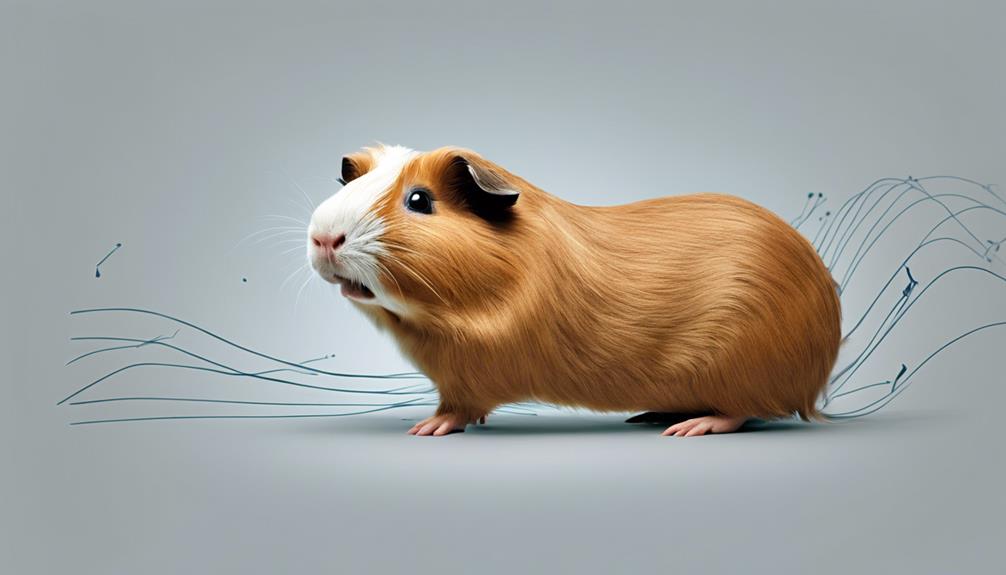What Are the Signs of Heatstroke in Guinea Pigs?

Heatstroke is a serious condition that can be fatal if not treated promptly. Guinea pigs are particularly susceptible to heatstroke due to their inability to sweat and regulate their body temperature effectively. It is crucial to provide them with a cool, well-ventilated environment, plenty of fresh water, and avoid exposing them to high temperatures. If you suspect your guinea pig is suffering from heatstroke, seek veterinary attention immediately.
Key Takeaways
- Elevated body temperature, excessive panting, and drooling are common signs.
- Breathing difficulties and lethargy may accompany heatstroke symptoms.
- Uncontrolled convulsions and muscle spasms can occur in severe cases.
- Immediate veterinary attention and cooling measures are crucial for treatment.
Understanding Heatstroke in Guinea Pigs
Heatstroke in guinea pigs occurs when their bodies are unable to regulate temperature effectively, leading to potentially life-threatening consequences. Preventing heatstroke is paramount in caring for these small, delicate creatures. Guinea pigs are highly susceptible to heat-related illnesses due to their limited ability to cool down. To safeguard them, make sure they've access to a cool environment with proper ventilation and shade. Additionally, always provide an ample supply of fresh, cool water to keep them hydrated, especially during warmer periods.
Emergency treatment for heatstroke in guinea pigs is critical and requires swift action. If you suspect your guinea pig is suffering from heatstroke, move them to a cooler area immediately. Use cool (not cold) water to dampen their fur and help lower their body temperature gradually. Contact a veterinarian promptly for further guidance and medical intervention. Remember, quick and decisive action can make all the difference in saving your beloved guinea pig from the perils of heatstroke.
Elevated Body Temperature
In the domain of guinea pig care, monitoring for signs of an elevated body temperature is pivotal to safeguarding their well-being and preventing potential heat-related complications. Guinea pigs are highly sensitive to heat, making it essential to recognize when their body temperature is rising. When observing an elevated body temperature in a guinea pig, swift action is essential.
Cooling methods are important in such situations. Placing a cool, damp towel in their living space or gently misting them with water can help lower their body temperature. Additionally, ensuring proper ventilation and access to fresh, cool water is essential in preventing heatstroke.
Prevention tips can go a long way in avoiding elevated body temperatures in guinea pigs. Ensuring their living environment is adequately ventilated, avoiding direct sunlight exposure, and providing shady areas for them to retreat to are proactive measures to prevent overheating. By staying vigilant and implementing these cooling methods and prevention tips, caregivers can help keep their guinea pigs safe and comfortable during warm weather.
Excessive Panting and Drooling
Excessive panting and drooling in guinea pigs are telltale signs of heatstroke, indicating their struggle to regulate body temperature. These symptoms may be accompanied by breathing difficulties, lethargy, and weakness, which require immediate attention to prevent further complications.
Recognizing these early warning signs and providing prompt cooling measures can help safeguard the well-being of these small, vulnerable pets.
Breathing Difficulties
Panting and drooling excessively can indicate significant breathing difficulties in guinea pigs, signaling a potential heatstroke emergency. When a guinea pig experiences respiratory distress due to overheating, prompt treatment is essential. Providing immediate cooling methods and moving the guinea pig to a cooler environment can help alleviate the breathing difficulties. Prevention is key in avoiding such distressing situations; ensuring a well-ventilated cage and keeping the environment cool can greatly reduce the risk of heatstroke. Below is a table summarizing the key points for recognizing and addressing breathing difficulties in guinea pigs:
| Signs of Breathing Difficulties | Actions to Take |
|---|---|
| Excessive panting | Provide immediate cooling |
| Drooling | Move to a cooler area |
Lethargy and Weakness
Weakness and lethargy, accompanied by excessive panting and drooling, may indicate a serious health concern in guinea pigs. When a guinea pig displays these symptoms, it's important to assess its energy levels, hydration, activity level, and appetite.
A lethargic guinea pig may appear uninterested in its surroundings, moving less than usual, and showing a lack of enthusiasm for activities it typically enjoys. Additionally, weakness can manifest as difficulty in moving around or an overall lack of strength.
Monitoring these signs closely is essential as they could be indicative of an underlying issue that requires immediate attention. Ensuring the guinea pig has access to fresh water, a cool environment, and veterinary care is important in helping it recover from potential heatstroke or other health complications.
Lethargy and Weakness
Amidst the subtle signs of distress that may accompany heatstroke in guinea pigs, a notable indicator often manifests in the form of lethargy and weakness. When a guinea pig is experiencing heatstroke, it may appear unusually tired, lacking its usual energy and vitality. This lethargy is an important symptom not to be overlooked, as it signals potential danger to the pet's well-being.
To address lethargy and weakness in a guinea pig suffering from heatstroke, prompt action is essential. Providing immediate treatment options such as moving the guinea pig to a cooler environment, offering water to drink, and gently cooling its body with a damp cloth can help alleviate the symptoms. Additionally, prevention tips play a crucial role in safeguarding guinea pigs from the perils of heatstroke. These include ensuring a well-ventilated living space, keeping the cage out of direct sunlight, providing access to fresh water at all times, and monitoring the temperature regularly to intervene before heatstroke occurs.
Rapid Heart Rate

With an accelerated rhythm akin to a drum beating fervently, a guinea pig suffering from heatstroke may exhibit a rapid heart rate as a pivotal indicator of distress. This manifestation is an important indicator of the severe physiological strain the animal is enduring due to overheating. Guinea pig owners must be vigilant in recognizing this symptom promptly, as a rapid heart rate in these small creatures can quickly escalate into a life-threatening situation if left untreated.
Prevention methods play a crucial role in safeguarding guinea pigs from heatstroke-induced complications. Ensuring proper ventilation in their living environment, providing access to cool areas, and keeping them hydrated are essential preventive measures. In cases where a guinea pig does develop heatstroke, swift action is imperative. Treatment options include cooling the animal gradually, offering water for rehydration, and seeking immediate veterinary care if the situation worsens.
Understanding the risk factors and long-term effects associated with heatstroke in guinea pigs is important for their overall well-being. By being attentive to their health and environment, owners can help mitigate the risks and important the long-term health of their beloved pets.
Tremors and Seizures
Experiencing rapid heart rate as a precursor, guinea pigs affected by heatstroke may also demonstrate tremors and seizures, indicating a critical escalation in their distress. These neurological manifestations serve as red flags, urging immediate action to alleviate the suffering of these delicate creatures.
To aid those seeking to serve their furry companions better, here are some important points to take into account:
- Tremors: Guinea pigs may exhibit uncontrollable shaking or trembling throughout their bodies, signaling severe neurological involvement.
- Seizures: In advanced stages of heatstroke, guinea pigs can experience seizures characterized by uncontrolled convulsions and muscle spasms, requiring urgent attention.
- Treatment Options: Quick response is essential; move the guinea pig to a cool, shaded area, offer water to drink, and gently wet their fur with cool (not cold) water. Contacting a veterinarian immediately is crucial for further guidance and treatment options.
- Comfort and Care: Provide a quiet, stress-free environment post-treatment, ensuring the guinea pig has access to water and food to aid in their recovery.
Dehydration and Sunken Eyes

Dehydration in guinea pigs often manifests through sunken eyes, indicating a critical state of fluid loss that requires immediate attention. When a guinea pig's eyes appear sunken, it's a clear indication that the little furry friend is in need of hydration. As responsible caregivers, it's essential to be vigilant for this sign, as dehydration can have serious consequences if left unchecked.
To combat dehydration and prevent sunken eyes in guinea pigs, hydration tips are paramount. Providing fresh, clean water at all times is important. Additionally, incorporating vegetables with high water content, such as cucumbers and lettuce, into their diet can help maintain proper hydration levels. Monitoring their water intake and ensuring they're drinking regularly is key to preventing dehydration.
Preventative measures play an important role in safeguarding guinea pigs from dehydration and its associated risks. By creating a comfortable living environment with adequate ventilation and shade, you can help regulate their body temperature and prevent excessive fluid loss. Remember, a well-hydrated guinea pig is a happy and healthy one.
Collapse and Unresponsiveness
Amidst the distressing signs of heatstroke in guinea pigs, the occurrence of collapse and unresponsiveness can be particularly alarming.
Loss of consciousness, accompanied by lethargy and weakness, signifies a critical stage of heat exhaustion in these small animals.
Recognizing these symptoms promptly and seeking veterinary assistance is essential in ensuring the well-being of a guinea pig suffering from heatstroke.
Loss of Consciousness
In some cases, a guinea pig experiencing heatstroke may exhibit a concerning loss of consciousness, characterized by collapse and unresponsiveness. When faced with a guinea pig in this critical state, it's essential to act swiftly and decisively to provide the necessary care. Here are some key points to contemplate in such a situation:
- Assess the Situation: Check the guinea pig's breathing and responsiveness.
- Move to a Cool Environment: Transfer the guinea pig to a cooler area immediately.
- Apply Cool Compresses: Dampen a cloth with cool water and gently apply it to the guinea pig's body.
- Seek Veterinary Assistance: Contact a veterinarian promptly for further guidance and treatment.
Lethargy and Weakness
The manifestation of lethargy and weakness in a guinea pig, often accompanied by collapse and unresponsiveness, signals a critical need for immediate intervention to address potential heatstroke. When observing these concerning symptoms, swift action is vital to prevent further deterioration of the pet's health.
Treatment options for heatstroke in guinea pigs may include cooling measures such as gently wetting the fur with cool water, moving the animal to a cooler environment, and seeking veterinary assistance promptly. The recovery process from heatstroke can vary depending on the severity of the condition, with some guinea pigs requiring supportive care such as fluid therapy.
To prevent heatstroke, make sure your guinea pig has access to a cool, shaded area, provide fresh water regularly, and avoid exposing them to high temperatures. Hydration tips include offering water-rich foods like cucumber and ensuring a constant supply of fresh water.
Frequently Asked Questions
Can Heatstroke in Guinea Pigs Be Prevented With Certain Environmental Modifications?
Ironically, one might think that environmental modifications alone could prevent heatstroke in guinea pigs. While they play a vital role, other key factors like breed susceptibility and understanding heatstroke risks are equally important.
Are Certain Guinea Pig Breeds More Susceptible to Heatstroke Than Others?
Certain guinea pig breeds may exhibit varying susceptibility to heatstroke due to factors like coat length and density. Environmental factors such as ventilation, hydration, and access to shade play vital roles in preventing heat-related issues.
How Quickly Should a Guinea Pig With Heatstroke Be Taken to the Vet for Treatment?
In case of heatstroke, it is important to act swiftly. Immediate emergency procedures are essential, and cooling methods should be applied while seeking vet availability. First aid can be administered, but professional help is paramount.
Can Guinea Pigs Recover Fully From a Severe Case of Heatstroke?
Can guinea pigs recover fully from a severe case of heatstroke? The recovery process for guinea pigs involves diligent care and patience. With proper rehabilitation techniques, most guinea pigs can make a full recovery, although the prognosis and recovery timeline may vary.
Are There Any Long-Term Effects on a Guinea Pig's Health After Experiencing Heatstroke?
In the recovery process from heatstroke, monitoring a guinea pig's health is essential. Potential complications may arise, requiring follow-up care. Ensuring diligent observation and necessary veterinary attention can help mitigate long-term effects on the guinea pig's health.











